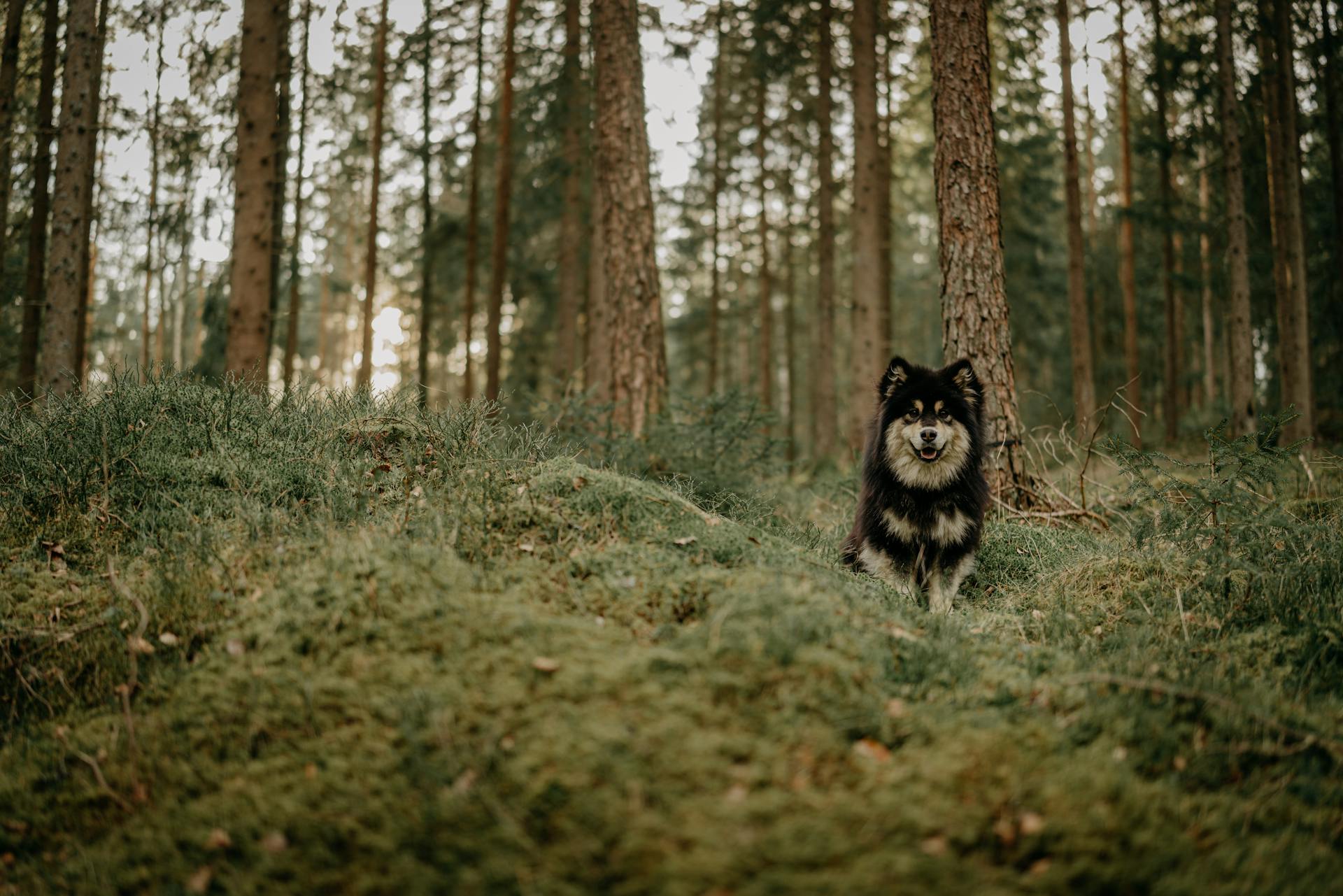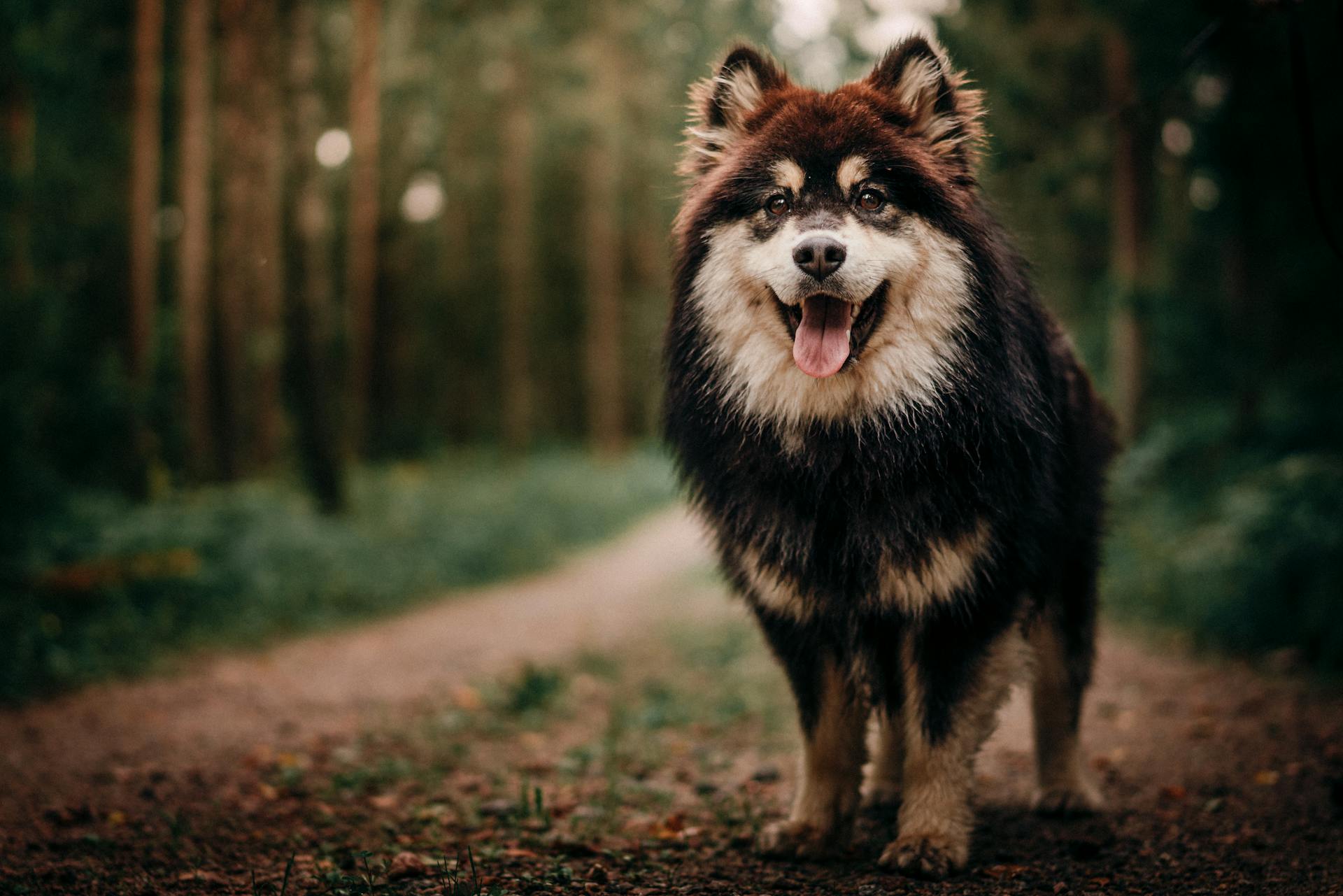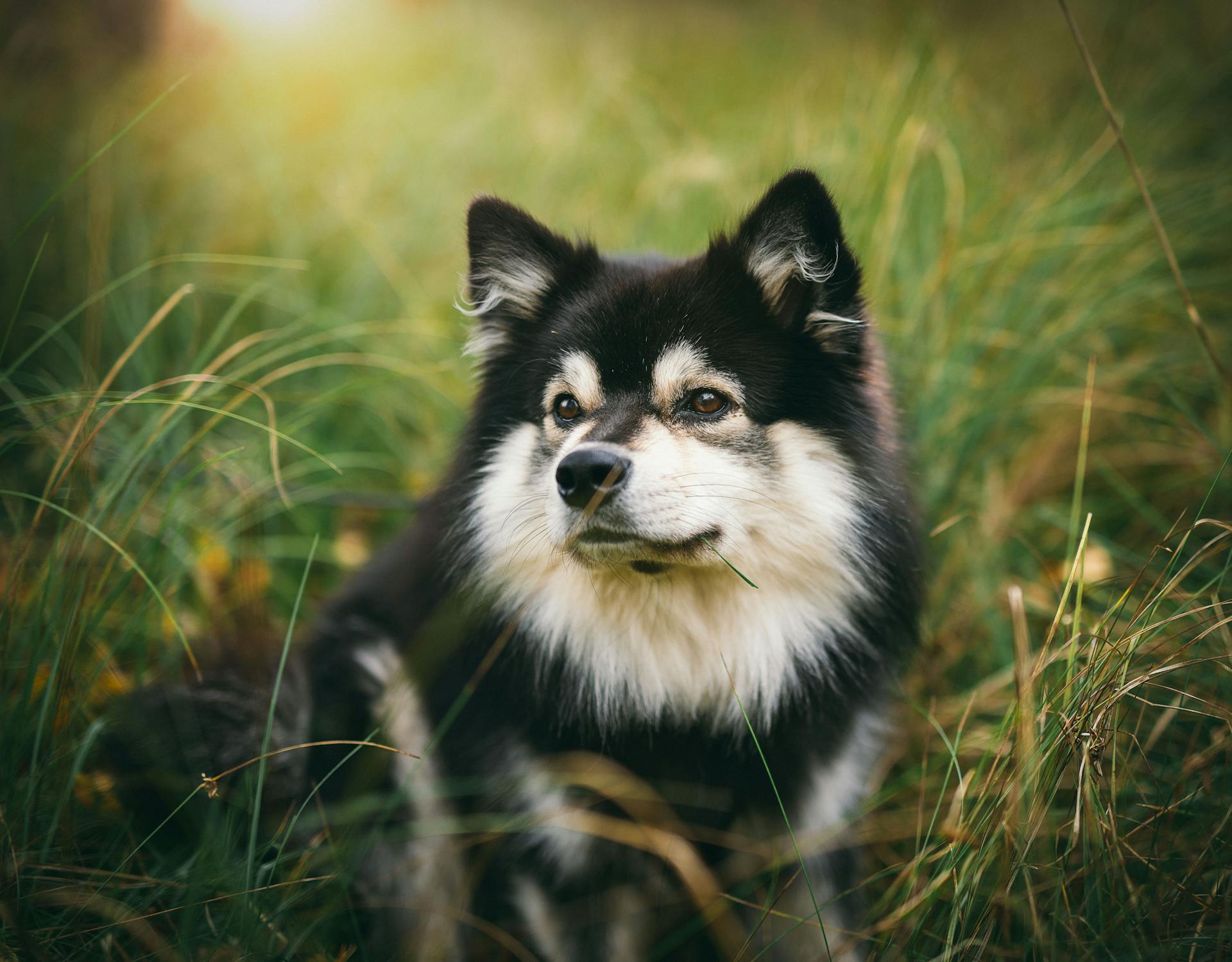
The Finnish Lapphund is a medium-sized dog breed that originated in Lapland, Finland. They are known for their distinctive appearance and friendly temperament.
These dogs typically weigh between 35-50 pounds and stand between 17-20 inches tall at the shoulder. They have a thick double coat that sheds heavily, so regular grooming is a must.
One of the best things about Finnish Lapphunds is their intelligence and trainability. They are highly responsive to commands and can learn quickly with positive reinforcement.
History and Origins
The Finnish Lapphund originates from Finland and was used by the Sami people to drive reindeer across the frozen tundra. They would bark and drive the deer across water and land, similar to a sheepdog driving sheep.
The breed has been around for thousands of years and was well suited to working the harsh conditions of the area. The Sami people say "Give the first bite [of your meal] to your dog and they will work harder for you", highlighting the importance of their canine companions.
The Finnish Lapphund is an old dog breed, whose ancestry goes back to hundreds of years. It belongs to the same group as Swedish Elkhound and Norwegian Elkhound.
These dogs are hybrids of male dogs and female wolves. They were bred to guard makeshift shelters and to hunt reindeers, beavers, and foxes.
The use of Lapphunds has evolved through civilizations. Initially, the semi-nomadic Sami people, living in northernmost Scandinavia, bred Lapphunds for hunting.
The breed was later developed for herding, with years of training leading to the development of a loyal, trainable, and submissive dog.
The Finnish Lapphund was recognized by the Finnish Kennel Club (FKC) in 1945 as a distinct canine breed. It was then named the Lapponian Shepherd Dog.
The FKC identified two types of this breed: the long-haired and short-haired. In 1967, these two types were separated. The long-haired Lapponian became Finnish Lapphund while the short-haired breed became Lapponian Herder.
The Finnish Lapphund first came to the United States in 1987. It was recognized by the United Kennel Club in 1994.
If this caught your attention, see: Finnish Lapphund Brown
Physical Characteristics
The Finnish Lapphund has a strong and straight back, and although their head is powerful, their eyes are soft and soulful.
Their triangular ears are set far apart on their head, and are very mobile, carried either erect or semi-erect.
Males have a bigger coat around the ruff, and females weigh between 33 and 44 pounds, while males weigh between 42 and 53 pounds.
The breed is medium-sized, with males ranging in height from 18 to 20½ inches, and females ranging in height from 16 to 18½ inches.
Their hindquarters are straight and strong, full of power for a day of herding reindeer, and their forelegs are straight and seemingly short as compared to the rest of the body.
If this caught your attention, see: How Much Do Collies Weigh
Coat and Coloring
The Finnish Lapphund's coat is a double coat, consisting of a long and coarse outer coat and a soft and dense undercoat.
Their coat is essential for living and working in harsh Arctic environments.

The outer coat is longer on the brisket, backs of thighs, and tail, while the hair on the skull and front parts of the legs is shorter.
The hair on the cheeks, neck, and throat forms a protective ruff.
All colors are allowed, but one color must predominate, with markings of other colors allowed on the head, neck, chest, legs, and the tip of the tail.
The most common colors include black, brown, and grey tones, with some members of the breed also having light or tan markings throughout.
Their coats can be with or without tan and white markings, with the tan ranging from lightest cream to deep caramel.
Males have a bigger coat around the ruff, while the coat is shorter on the head and forelegs but thicker on the rear.
Expand your knowledge: Bull Terrier Head Shape
Traits
The Finnish Lapphund is a medium-sized dog with a sturdy build, weighing between 33 and 53 pounds.
Their coat is a double coat, with a long and coarse outer coat and a soft and dense undercoat. The coat can be any color, but a single color must predominate.
If this caught your attention, see: Pembroke Tri Color Corgi
Their triangular ears are set far apart on their head and are very mobile, carried either erect or semi-erect. The ears are broad at the base and medium-sized.
Their eyes are soft and soulful, and their brown oval-shaped eyes are typically harmonized with the coat's color. Their broad face and light coat around their eyes give them a distinctive appearance.
Their hindquarters are straight and strong, full of power for a day of herding reindeer. Their forelegs are straight and seemingly short as compared to the rest of the body.
Their tail is long and brushy, curling over their straight back when they're moving. The tail is covered with long hair and is a distinctive feature of the breed.
Their size can be deceiving, as they may appear larger due to their thick coat. In reality, females weigh between 33 and 44 pounds, while males weigh between 42 and 53 pounds.
Intriguing read: Straight Backed German Shepherds
Height
The Finnish Lapphund is a medium-sized dog with a unique appearance. A mature male Finnish Lapphund ranges in height from 18 to 20½ inches, measured at the withers.
Females are slightly shorter, with a height range of 16 to 18½ inches.
Related reading: Swedish Lapphund Puppies
Weight

Weight is a crucial aspect of our physical characteristics. A person's weight is typically measured in kilograms or pounds and is influenced by their body composition, muscle mass, and bone density.
On average, an adult human weighs between 50 and 100 kilograms. This range can vary depending on factors such as age, sex, and body type.
Maintaining a healthy weight is essential for overall well-being and can help prevent chronic diseases like diabetes and heart disease.
Grooming and Care
The Finnish Lapphund's coat is a double-layered smooth and wavy profuse coat that requires regular grooming. Brushing once a week is enough to keep it in good shape, but during shedding season, you'll need to brush more frequently.
You'll want to use a slicker brush or a palm pin and a wide-toothed comb for thorough brushing. Scissors can also be used to trim the coat if needed.
The Finnish Lapphund's nails grow long and curly, and should be trimmed biweekly. You can use toenail clippers to keep them trimmed.
Here are some key grooming considerations:
Remember to bathe your Lappie once a month, using natural shampoos like lavender and tea tree. Regular dental care, including at-home teeth brushing and professional dental cleanings, is also essential for their overall health.
Grooming Guide
Grooming your Finnish Lapphund is essential to keep them looking and feeling their best. Brushing once a week is enough to keep their coat in good shape, but during shedding season, regular grooming is necessary.
You'll need a slicker brush or a palm pin and a wide-toothed comb for thorough brushing. Scissors work well if you want to trim their coat.
Their nails grow long and curly, so be sure to trim them biweekly. You can use toenail clippers to keep their nails tidy.
Puppies have fine texture coats that require daily grooming. As they age, their coats change to a more coarse and straight texture, making it easier to brush.
Bathing your Lappie once a month is fine, but be sure to use natural shampoos like lavender and tea tree oil.
Ear Care
Cleaning your dog's ears is an essential part of their grooming and care. You should talk to your veterinary team about how often to clean their ears and which ear-cleaning products to use.
Redness, odor, pain, itchiness, and head shaking are all signs of an ear infection that you should call your vet about right away.
Health and Nutrition
Finnish Lapphunds are generally a healthy breed, but like all dogs, they can be prone to certain health issues. They have an average lifespan of 12 to 14 years.
Their eyes are a concern, as they can be affected by Progressive Retinal Atrophy (PRA), which can cause night blindness and eventual blindness. The first sign of PRA is often night blindness, so keep an eye out for that.
Hip and elbow dysplasia are also potential issues, especially in young Lappies. These conditions can be caused by a combination of genetic and environmental factors, and can lead to arthritis and mobility problems. Excessive nutrient intake can increase the risk of elbow dysplasia.
Pompe's disease is a rare but serious condition that affects young Lapphunds, causing vomiting and aspiration pneumonia. It's essential to work with a reputable breeder who has had their dogs tested for these conditions.
A balanced diet is crucial for maintaining your Lapphund's health. Puppies need a diet rich in high-quality protein, and adult dogs require a nutrient-rich adult dog food. The recommended daily calorie intake for a Lappie is around 1100, but this can vary depending on activity level.
It's also essential to monitor your Lapphund's weight, as obesity can lead to health problems like elbow dysplasia. Limit table food and maintain high hygiene by cleaning their bowls after each meal. Fresh water should be provided daily.
You might enjoy: Are Border Collies High Maintenance
Health

Finnish Lapphunds are generally a healthy breed, but like all dogs, they can be prone to certain health issues. They typically live between 12 to 15 years.
Progressive Retinal Atrophy (PRA) is a common health issue in Finnish Lapphunds, which can cause blindness. PRA begins to show signs between the ages of five to eight.
Night blindness is often the first sign of PRA, where your dog bumps into objects at night. Other signs include hyperreflectivity at the back of the eye and dilated pupils.
Hip and elbow dysplasia are also common health issues in Finnish Lapphunds. These conditions can cause arthritis and joint pain. Hip dysplasia can begin as early as four months old.
Pompe's disease is a rare but serious health issue in young Finnish Lapphunds, which can cause regurgitation and aspiration pneumonia.
To minimize the risk of these health issues, make sure to work with a certified breeder who has performed CERF examinations on their dogs. Regular check-ups with your veterinarian are also crucial to monitor your dog's health.
Here are some common health issues in Finnish Lapphunds:
- Progressive Retinal Atrophy (PRA)
- Canine Hip Dysplasia (CHD)
- Canine Elbow Dysplasia (CE)
- Pompe's disease
By being aware of these potential health issues, you can take steps to prevent or manage them, ensuring your Finnish Lapphund lives a long and happy life.
Diet and Nutrition
Finnish Lapphunds are active dogs that require a lot of energy for growth and play.
A diet rich in high-quality proteins is essential for puppies, who need about 1100 daily calories on average, although calorie intake varies based on activity levels.
Growing puppies consume more calories than adult dogs, so they need a diet that can keep up with their high energy needs.
Old dogs, on the other hand, need fewer calories as they age.
General puppy food will suit your young Lappies, but adult dog food approved by AAFCO is excellent for mature Lapphunds.
Limit table food since it can cause obesity, mineral/vitamin deficiencies, and bone/teeth issues in your Lappie.
Maintain high hygiene by cleaning the dog’s bowls after each meal and giving fresh water every day.
It's essential to partner with your veterinarian to develop a feeding plan that's nutritionally complete and balanced for your pup's age, size, and health history.
See what others are reading: Best Food for Border Collies

This will help ensure your Lappie gets the right nutrients at the right time.
If your Finnish Lapphund is eating a dog food approved by the Association of American Feed Control Officials (AAFCO), they shouldn’t need anything extra, but your veterinarian may recommend nutritional supplements to treat certain health conditions.
Remember to factor treats into your dog’s daily calorie count, as they can add up quickly and make up no more than 10% of your dog’s daily diet.
Most adult Lappies should eat two meals a day, but puppies may need three meals due to their high metabolism.
See what others are reading: Do Border Collies Need to Be Groomed
Teeth
The Finnish Lapphund's teeth are a notable feature. They have a complete set of evenly spaced, white teeth.
Their teeth meet in a scissors bite, which is a specific and desirable arrangement. This means that the upper teeth fit over the lower teeth in a way that's both functional and aesthetically pleasing.
The Finnish Lapphund's bite is considered disqualifying if it's undershot or overshot. This means that a dog with a significantly receding or protruding jawline is not considered a purebred.
Check this out: Finnish Lapphund Breeders
Frequently Asked Questions
Do Finnish Lapphunds bark a lot?
Finnish Lapphunds are known to be noisy herders with a tendency to bark frequently. Training can help minimize barking, but it's essential to consider their communicative nature when deciding if they're the right fit for your lifestyle.
Can Finnish Lapphunds be left alone?
Finnish Lapphunds can't be left alone for long periods, as they're pack dogs that thrive on family interaction. Leaving them alone for too long can lead to undesirable behaviors.
Are Finnish Lapphunds good family dogs?
Yes, Finnish Lapphunds can make great family dogs, but they thrive on companionship and require regular interaction to prevent undesirable behaviors. They're best suited for families who can provide attention and affection.
Do Finnish Lapphunds smell?
Finnish Lapphunds are known to be odor-free, but regular grooming is still necessary to prevent matting.
Do Finnish Lapphunds like to cuddle?
Finnish Lapphunds are known for their affectionate nature and love to snuggle up with their owners. Their soft coat is just one reason they make great cuddle buddies.
Featured Images: pexels.com
